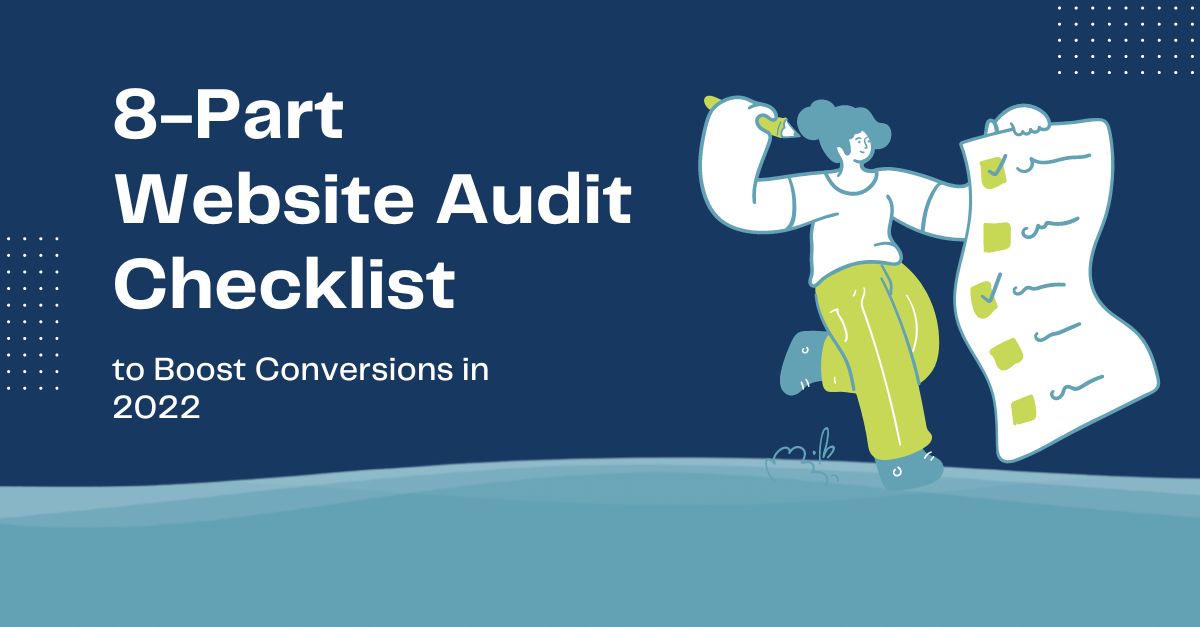Your business isn’t the same as it was five years ago. You probably have different employees, new clients, and more sophisticated systems. You might sell products or services you didn’t offer before and may have eliminated offerings that weren’t profitable or popular with your niche audience.
More than likely, you already perform regular check-ups with different departments and employees to identify what’s working and what isn’t. These analyses can help you focus your attention on what matters most – and fix what’s broken.
You’d never dream of letting your business sail along with no one at the helm, right? The question is, have you given the same care and attention to your website? Our website audit checklist will help you do just that.
What is a website audit?
A website audit is a full-spectrum analysis of one of your business’s most valuable tools. It involves a thorough inspection of all the factors affecting your website’s overall performance and effectiveness, including its:
- Visibility
- Rank-ability
- Technical performance
- User experience
- Design
- And more
An audit provides insight into what’s working well and shows you areas that need immediate attention and improvement.
Why do you need to audit your website?
Ideally, your website should load quickly, be visually appealing, and provide helpful information for users. These features encourage people to stay on your website longer than a slow, hard-to-navigate, or cluttered site would. An audit gives you insights into your website’s speed, responsiveness, and overall functionality.
By acting on problem areas you identify while completing your website audit checklist, you can improve conversion rates and increase your site’s overall usefulness to your business. You’ll also detect issues causing your site to rank poorly on search engines like Google. Optimizing your site to offer the best user experience and most relevant content is essential.
Tools to Help You Complete Your Website Audit Checklist
We recommend gathering some or all of these helpful tools to complete your website audit checklist. Request access to the following applications (if necessary), or set them up if you’re using them for the first time.
- Google Analytics
- Your CMS
- Google Search Console
- Google PageSpeed Insights and GTmetrics (for page speed)
- Ahrefs (or another keyword research and SEO tool)
- Information on your target audience
- Mobile device (to manually test your site)
- Website grader
- Website accessibility checker (like WebAccessability.com)
Your 8-Step Website Audit Checklist
Each step in our website audit checklist is an essential component of a thorough analysis.
- Website Performance
- Website Health
- SEO Content
- Technical SEO
- Design and User Experience (UX)
- Conversion Rate Optimization
- Security
- Accessibility
1. Website Performance
An excellent first step to measure your site’s current performance is to run your URL in a website audit tool (like this website grader). This tool will test your site on various performance metrics and generate a speed score for both mobile and desktop.
Your website page’s speed has a dramatic effect on your conversion rate. A 0-4 second load time is best for conversion rates. Your page speed depends on several factors, including the page type, file sizes, website server/host, coding, hotlinking, plugins, and widgets. Tools like PageSpeed Insights or Lighthouse let you analyze your site’s load time and resolve issues that might be causing delays.
In addition to analyzing the speed, include the following in your website audit checklist:
- Make sure your site loads correctly and completely.
- Ensure it’s readable on both desktop and mobile formats.
- Make sure it’s easy to navigate.
- Minimize pop-ups and intrusive ads that distract from the user experience.
2. Website Health
A thorough website audit will reveal errors like broken links, 404 “page not found” issues, and unintended redirects. These errors make your website more difficult to navigate and reduce your credibility. Links to pages that no longer exist can make your content seem outdated or sloppy. They can also affect your website’s speed and overall performance. An audit will help you cleanse broken or dead links from your system.
Your website also needs to perform well on mobile devices. As of late 2021, mobile devices (excluding tablets) generated 54.4 percent of global website traffic. Use Google’s Mobile-Friendly Test tool to check your site’s mobile health. An audit can help you identify what’s causing issues.
3. SEO Content
All content across your website should be well-written, informative, easy to read and understand, and grammatically correct. This includes the copy on every page, including blog posts, graphics, and downloadable content. Your content should be relevant, current, and valuable to your target customers. Don’t be afraid to get rid of or archive out-of-date and unhelpful information. Making content as appealing as possible to search engines is called “search engine optimization,” or SEO.
Search engines can penalize you for having duplicative content (content that’s word-for-word identical on various pages or parts of your site). For example, if you have multiple pages of similar but geo-specific content, make sure they don’t contain substantially identical text. Similarly, ensure your website doesn’t plagiarize text from other sites.
You can manually review and optimize your content during an audit if you have a small website. For large websites, this can be impossible. Opt for tools like Google Search Console and Google Analytics to find the pages that generate the most (and least) traffic. Target these to refresh, review, or eliminate them altogether.
4. Technical SEO
A technical SEO audit involves inspecting the coding for your site. Each page should be analyzed for its content, structure, on and off-page SEO, HTML errors, and adherence to best practices that improve its ranking.
Every page should have a unique, optimized title and meta description within the correct length limits. A well-written meta description gives a searcher a good impression of the page’s “main idea” and encourages them to click the link. Your title tags and meta descriptions should satisfy a user’s search intent.
Audit tools like Ahrefs or Semrush can help you understand your site’s search engine performance. You can see which keywords your site ranks highest for and whether these are the keywords you want to rank for. For example, if you run an auto insurance agency, you may not benefit from being well-ranked for “life insurance” keywords.
A site audit can help you pinpoint which keywords you’re already ranking highly for and identify additional keywords you need to target for improvement. Tools like Google Analytics and TrueRanker track the keywords that rank higher in SERPs (search engine results pages). You can also identify the keywords your competitors currently rank highly for and use that information to create relevant, valuable, and competitive content.
5. Design and User Experience (UX)
A website audit also examines the overall design of your website and how users experience your business online.
- Does your site look outdated?
- Is it difficult to read because of the typeface, colors, or images?
- Is it too busy or distracting?
- Is there enough information to guide users where they need to go?
Often, less is more when it comes to website design. Having a clean site that’s easy to use and strategically designed can get people where they need to go quickly – so they don’t leave confused or frustrated. Don’t hesitate to scrap graphics, pages, and plugins that detract from the user experience.
Make sure you have a public sitemap file for users to access. You also need a well-organized XML sitemap, which provides information to search engines about the pages on your site and how they are structured. Optimizing your sitemap can help Google index your site’s URL faster.
6. Conversion Rate Optimization
A thorough audit should include evaluating your website’s effectiveness for lead generation and conversion. This includes your “bounce rate,” which is the percentage of visitors that leave each page without taking action (like clicking on a link, filling out a form, or making a purchase). An audit can identify where your site is missing opportunities to convert visitors into leads on landing pages.
Regular site audits can show you which pages are getting the most traffic and engagement so you can further optimize them. Add relevant CTAs (calls to action) on your “star players” to boost conversions, drive more sales, and increase ROI.
7. Security
Regular audits can also reveal potential vulnerabilities and weaknesses in your site’s performance and infrastructure. Keeping your data secure and protecting your customer’s sensitive information is vital.
Every one of your site’s URLs should use HTTPS protocol. The extra “s” at the end indicates that the site has an SSL certificate. These small data files establish an encrypted link between a web server and a browser, ensuring data that passes between the web server and browser is private. Besides keeping your data safe from hackers, using HTTPS is a positive ranking factor on Google.
Also check to ensure reliable security plugins are installed and updated, and no other general security issues exist on your website. Finally, provide an adequate data backup plan in case your site fails.
8. Accessibility
Web accessibility, or eAccessibility, refers to practices that improve interaction with and access to websites by people with physical disabilities, situational disabilities, and socio-economic restrictions on bandwidth and speed. Tools like WAVE and WebAccessibility.com can help you understand what aspects of your website may be difficult for certain groups of users and provide solutions that increase accessibility.
Hire a Team of Experienced Website Auditors
If it’s been too long since you’ve cleaned your online house, we can help. Our experienced team can efficiently audit your website to improve its performance and effectiveness. Our web designers are equipped and excited to provide the technical knowledge and creative prowess you need to rejuvenate your website. If you’re ready to get started, contact Port & Starboard today!





